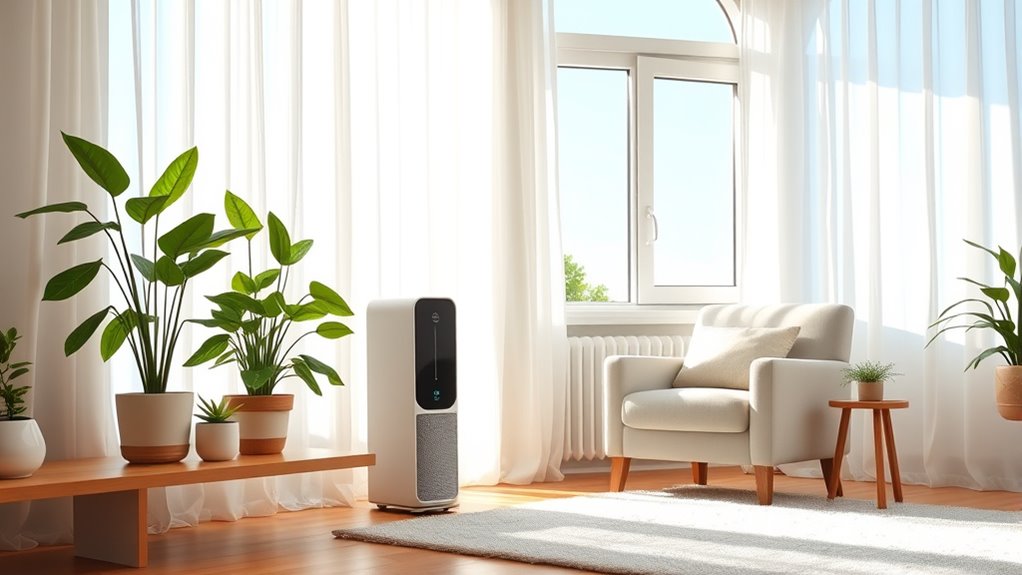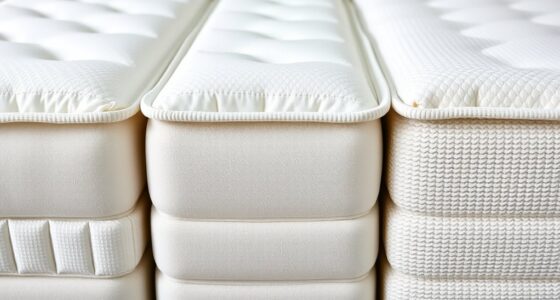To improve indoor air quality for allergies, keep humidity levels between 30-50% using a hygrometer and dehumidifiers. Use high-quality HEPA filters and change them regularly to trap allergens effectively. Clean frequently with damp cloths and vacuum with a HEPA filter. Minimize triggers by washing bedding often, replacing carpets with hard floors, and choosing allergy-friendly houseplants. Better ventilation and air purifiers can also help. Looking into these tips will show you how to create a healthier indoor environment.
Key Takeaways
- Maintain indoor humidity between 30-50% to prevent mold growth and reduce allergens.
- Use HEPA filters and regularly change air filters to trap dust, pollen, and pet dander effectively.
- Increase ventilation by opening windows and using exhaust fans to improve air circulation.
- Reduce indoor allergens by washing bedding, curtains, and soft furnishings frequently in hot water.
- Keep pets out of bedrooms and clean indoor plants regularly to minimize dander and mold spores.
Keep Humidity Levels in Check
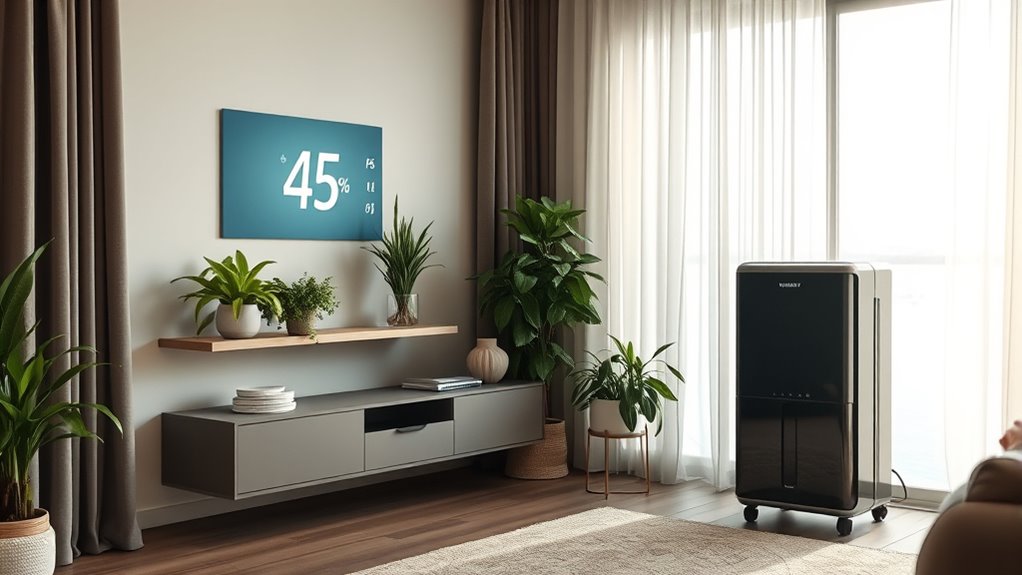
Maintaining proper humidity levels is essential for indoor air quality, as both excessively dry and overly humid air can cause health problems and damage your home. Using a dehumidifier helps control moisture, but regular dehumidifier maintenance is key to its effectiveness. Clean the filters and empty the water tank frequently to prevent mold growth inside the device. Proper humidity levels also reduce the risk of mold development in your home, which can worsen allergies and respiratory issues. Keep an eye on humidity readings with a hygrometer, aiming for 30-50%. When humidity stays within this range, it discourages mold spores from settling and proliferating. Regular dehumidifier maintenance and moisture monitoring ensure a healthier, mold-free environment for you and your family.
Use High-Quality Air Filters

Choosing the right air filter makes a big difference in your home’s air quality. HEPA filters trap more allergens and pollutants, keeping the air cleaner. Be sure to replace your filters regularly to maintain their effectiveness. Regularly inspecting and upgrading your filters can further improve overall indoor air quality, reducing allergy symptoms.
Choose HEPA Filters
To effectively improve your indoor air quality, investing in HEPA filters is essential. These filters trap tiny particles like pollen, dust mites, and pet dander, making your environment healthier. The benefits of HEPA filters include reducing allergy symptoms and improving breathing comfort. When choosing a filter, consider the following:
| Feature | Benefit |
|---|---|
| HEPA filter maintenance | Ensures peak performance and longevity |
| High filtration efficiency | Captures 99.97% of airborne particles |
Selecting high-quality HEPA filters supports cleaner air and lessens allergy triggers. Regular maintenance keeps your filter functioning at its best, maximizing the benefits of HEPA filters in your home. Make sure to check specifications and choose filters suited for your space for the best results. Proper filter selection and maintenance are crucial in managing indoor allergens effectively.
Replace Regularly
Regularly replacing your air filters guarantees they continue to effectively trap airborne particles and maintain ideal air quality. Proper air filter maintenance makes sure allergens don’t circulate freely, reducing allergy symptoms. Change filters every 1-3 months or more often if you have pets or allergies. Use high-quality, allergen-proof bedding to further improve indoor air. Keep these tips in mind:
- Check filters monthly for dirt buildup
- Follow manufacturer replacement guidelines
- Opt for filters with a high MERV rating
- Avoid reusing old filters
- Pair filter replacements with regular cleaning routines
- Consider upgrading to high-efficiency filters like HEPA or MERV 13+ for better allergen removal.
Regularly Clean and Dust Your Home
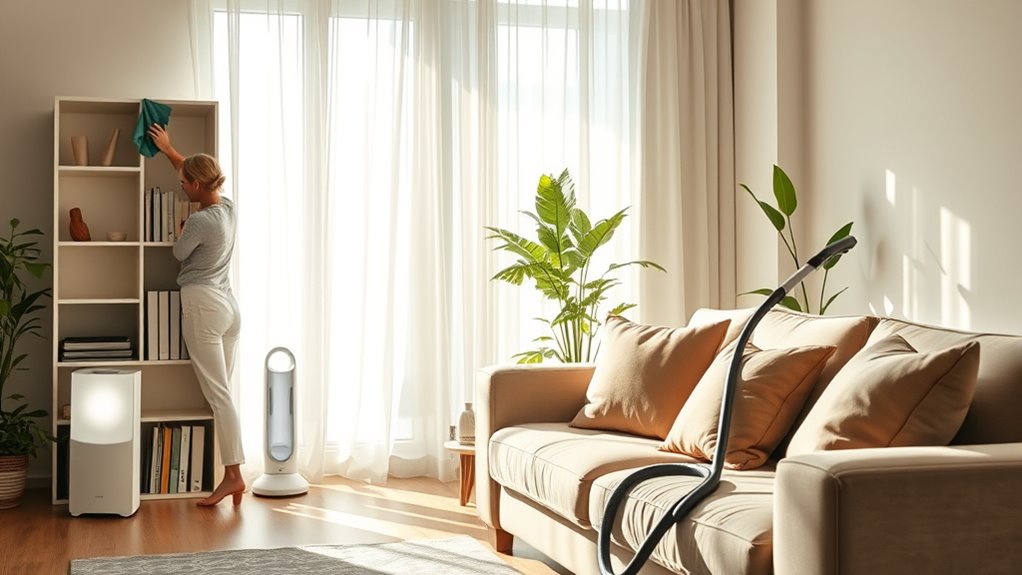
To keep indoor air clean, you should dust surfaces regularly to remove hidden allergens. Use the right cleaning products that effectively trap dust and germs without adding chemicals to the air. Staying consistent with these chores makes a noticeable difference in your home’s air quality. Additionally, avoiding the use of unnecessary advertisement cookies can help maintain a healthier indoor environment.
Dust Surfaces Frequently
Dust tends to settle quickly on surfaces, so maintaining regular cleaning is vital to preserve good indoor air quality. Frequent dusting helps reduce airborne allergens and prevents dust mites from thriving. When you dust, you remove particles that can trigger allergy symptoms and improve overall air cleanliness. Use a damp cloth or microfiber duster to trap dust effectively. Focus on high-touch areas like shelves, countertops, and furniture. Don’t forget to vacuum upholstery and curtains regularly. This routine minimizes dust accumulation and limits allergen circulation. Keeping surfaces dust-free not only promotes healthier air but also supports dust mite prevention, reducing potential allergy flare-ups. Additionally, staying aware of AI vulnerabilities can inform better strategies for managing smart home devices that control air quality systems, ensuring safer indoor environments. Consistent dusting is a simple yet powerful step toward a cleaner, allergy-friendly home environment.
Use Appropriate Cleaning Products
Choosing the right cleaning products makes a noticeable difference in maintaining good indoor air quality. Opt for natural cleaning options to reduce chemical exposures, especially if you have sensitivities. Look for products labeled as fragrance-free or designed for allergy sufferers. Avoid harsh chemicals, as they can trigger allergic reactions and worsen indoor air quality. Regular dusting and cleaning with these safer products help remove allergens like dust mites and pet dander. Consider the following:
| Cleaning Method | Suitable Products | Benefits |
|---|---|---|
| Dusting Surfaces | Natural dusting sprays, microfiber cloths | Reduces dust buildup |
| Vacuuming | HEPA filter vacuums | Captures tiny particles |
| Mopping | Vinegar-based solutions | Eliminates grime without chemicals |
Using HEPA filters in vacuum cleaners is especially effective at capturing microscopic allergens and improving overall indoor air quality.
Minimize Indoor Allergens and Triggers
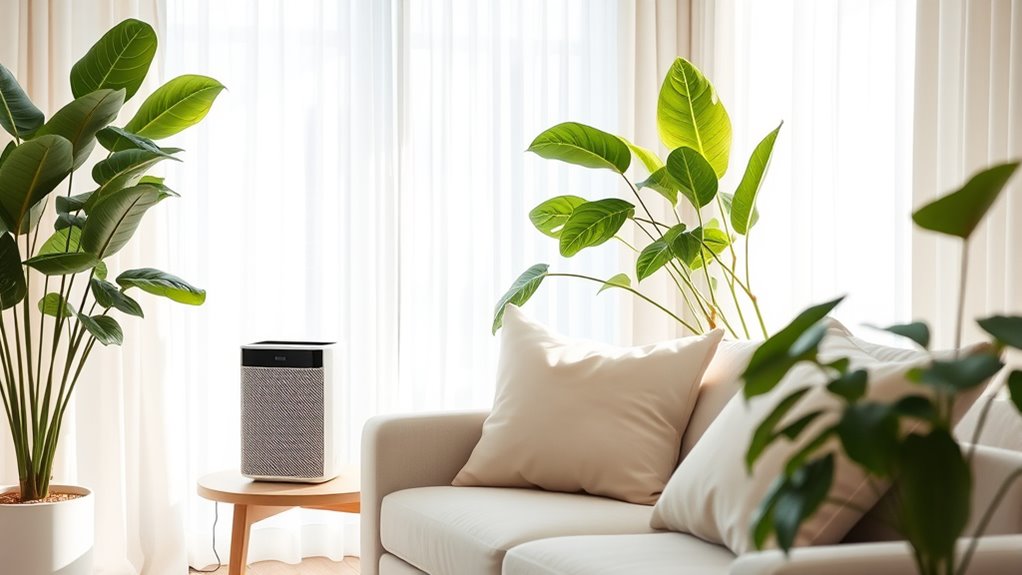
Indoor allergens and triggers can considerably impact your air quality, but you have the power to reduce their presence. Start by minimizing pet dander and indoor molds, which are common irritants. Keep pets out of bedrooms and wash their bedding regularly to cut down on dander. Use dehumidifiers to control humidity levels, preventing indoor molds from growing. Frequently clean surfaces with a damp cloth to trap dust and allergens. Avoid clutter that can trap dust and make cleaning harder. Consider replacing carpets with hard flooring, which is easier to keep allergen-free. Regularly wash bedding, curtains, and soft furnishings in hot water. Additionally, using an air purifier with HEPA filtration can help remove airborne allergens and improve overall air quality. By taking these steps, you can significantly improve your indoor air quality and reduce allergy symptoms.
Improve Ventilation and Air Circulation

Enhancing ventilation and air circulation is a powerful way to further improve your indoor air quality. By increasing air exchange, you guarantee fresh air continuously replaces stagnant indoor air, reducing pollutants and allergens. Open windows whenever possible to promote natural airflow patterns throughout your home. Use exhaust fans in kitchens and bathrooms to remove excess moisture and airborne particles. Arrange furniture to avoid blocking vents and ensure unobstructed airflow. Consider using ceiling fans or portable fans to improve air circulation, which helps distribute clean air evenly and prevents the buildup of allergens in specific areas. Proper airflow patterns prevent stagnation and help maintain a healthier indoor environment. Regularly changing air filters also plays a crucial role in supporting good ventilation. Incorporating natural materials such as wood and linen can also help promote better air quality indoors by reducing synthetic emissions.
Choose Allergy-Friendly Houseplants

Opting for allergy-friendly houseplants can boost indoor air quality without triggering allergy symptoms. Choose plants known for their low pollen production and minimal plant allergies. Be cautious of toxic soil, which can cause irritation or harm, especially if you have sensitive allergies. Opt for plants with non-toxic soil and avoid those that release airborne allergens. Some plants naturally filter air without aggravating allergies, making them perfect additions. To keep your plants allergy-friendly:
Choose low-pollen, non-toxic houseplants to improve air quality and reduce allergy triggers.
- Select plants like pothos or peace lilies
- Avoid plants with fuzzy or pollen-heavy leaves
- Use non-toxic, organic soil
- Keep plants clean to reduce mold and dust
- Limit the number of plants to prevent excess dust buildup
- Regularly inspect and remove dead or decaying leaves to prevent mold growth to maintain a healthy indoor environment
Consider Air Purification Devices

While choosing allergy-friendly houseplants helps improve air quality naturally, adding air purification devices can further reduce airborne pollutants. There are various air purifier types, including HEPA filters, activated carbon, and UV models, each targeting specific allergens and pollutants. When selecting a device, consider your allergy triggers and room size to find the most effective option. Proper device maintenance is essential; regularly replacing filters and cleaning units ensure best performance. A well-maintained air purifier can considerably improve indoor air quality, making your home more comfortable and allergy-friendly. Additionally, understanding air quality factors can help you choose the right device and make informed decisions about improving your indoor environment. By combining these devices with natural solutions, you create a cleaner environment that minimizes airborne allergens and promotes better respiratory health.
Frequently Asked Questions
How Often Should I Change My Air Filters for Optimal Allergy Relief?
You should change your air filters every 1 to 3 months for ideal allergy relief. Regular filter maintenance helps prevent allergen buildup, ensuring cleaner indoor air. If you notice increased dust or your allergies worsen, consider replacing filters more frequently. Using high-efficiency filters can also trap more allergens. Staying consistent with filter changes keeps your HVAC system running efficiently and reduces airborne irritants, making your home more comfortable and allergy-friendly.
What Are the Best Types of Houseplants for Allergy Sufferers?
You should consider houseplants like Boston ferns, spider plants, or peace lilies, which are known for low pollen and minimal allergen production. These plants can improve indoor air quality without aggravating allergies. Make sure to keep your plants clean and use allergen filters to trap dust and pollen, further reducing allergy symptoms. Regularly checking and maintaining your houseplants helps create a healthier environment for allergy sufferers.
Can Indoor Air Purifiers Eliminate All Airborne Allergens?
Sure, indoor air purifiers seem like magic, but they can’t eliminate all airborne allergens. Their filter maintenance is vital; neglect it, and their effectiveness drops. While they considerably reduce pet dander, pollen, and dust mites, some allergens slip through, making total elimination impossible. Think of purifiers as helpful allies, not magic wands. To breathe easier, combine them with good ventilation and regular cleaning, rather than relying solely on them.
How Does Humidity Affect Mold Growth and Allergen Development?
Humidity levels directly affect mold growth and allergen development. When humidity is high, mold thrives and spreads, worsening allergy symptoms. To prevent mold, you should maintain indoor humidity between 30-50%. Use dehumidifiers and vents for mold prevention and humidity control, especially in damp areas like bathrooms and basements. Keeping humidity in the right range limits mold spores and allergens, creating a healthier indoor environment for allergy sufferers.
Are There Specific Cleaning Products Safest for Allergy-Sensitive Households?
Think of your home as a sanctuary, where gentle guardians keep allergens at bay. You should opt for eco-friendly cleaning products and natural disinfectants that act like soothing balms, not harsh storms. These safe choices effectively eliminate germs without releasing irritating chemicals into your air. By choosing natural, non-toxic options, you create a healthier environment, ensuring allergy-sensitive households breathe easier and feel more comfortable every day.
Conclusion
By following these tips, you can transform your home into a sanctuary free from allergens. Think of your indoor air as the silent visitor—will it bring comfort or chaos? Taking control of humidity, filters, and airflow turns the tide in your favor. Don’t wait for allergies to take center stage—act now and breathe easier every day. Your home’s air quality is the stage; make it a performance worth applauding.
